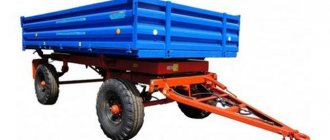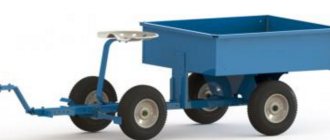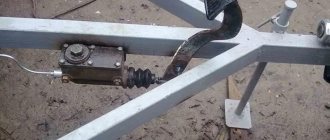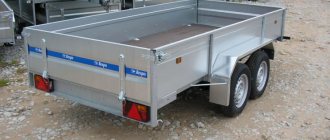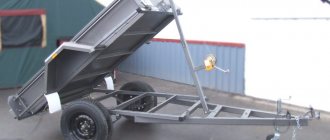Many rural residents have already appreciated the advantages of compact and economical mechanized agricultural machinery, among which a mini tractor can be distinguished.
However, such a vehicle can not only plow the land, but also transport all kinds of bulk and other cargo, which requires a good trailer. Considering the high cost of such products for mini tractors on the market, many of our compatriots are considering the option of creating such a cart with their own hands.
Tractor trailer device
The design of the tractor cart consists of the following parts:
- Wheels and chassis;
- Frames (frame part);
- Flatbed body;
- The mechanism responsible for lifting the body;
- Tow hitch.
Based on their functional features, tractor trailers come in two types:
- Single axle tractor trailer – popular models that are suitable for transporting bulk and semi-liquid materials;
- Biaxial – for machines transporting heavy loads or bulk materials in large quantities.
Depending on the type of trailed equipment, there are also two types of tractors: - The cart is a dump truck - the trailer is tilted by an automatic system. This type is simpler and more convenient. Unloading is performed by turning a special lever;
Forced tipping - the body is lifted by additional mechanical devices.
DIY tractor trailer
Before you start making a trailer, you need to develop drawings and prepare consumables: metal sheets, channels, plywood, chassis block, metal pipes, two wheels with the same radius.
A homemade cart is made according to the instructions in seven stages. The first stage is organization and planning. It is necessary to develop drawings and lay the technical foundations for the future device.
If we take into account all the dimensional characteristics, we get a spacious and reliable tractor cart, which has a stable wheel configuration and a powerful frame.
List of required materials for the trailer:
- Sheet steel;
- Channel, preferably steel or other durable material;
- Sheets of plywood;
- Metal or aluminum pipes;
- Running block;
- Wheels of equal diameter;
- Electrical equipment;
- Grinder or metal saw;
- Fasteners and other elements for securing structural parts.
The presence of electric welding will simplify the process of manufacturing the trolley, and will also strengthen all structural elements.
Drawbar for single axle tractor trailer
I had to tinker with the drawbar a little longer. The wheels of the cart - from GAE-53 (8.25R20) - have a diameter of 962 mm, and it turned out that when connected to the tractor, the frame was not installed in a horizontal position, but with a significant inclination. I had to “lower” the drawbar, and to do this, weld a reel under it from a channel with dimensions of 100x45x4 mm, in addition, put a trailing thrust plate in front with dimensions of 150x20 mm. After this, the frame “leveled out”.
Frame front:
1 – front traverse; 2 – drawbar; 3 – transverse reinforcement; 4 – shook; 5 – stop
Manufacturing process of key trailer parts
Scheme for creating a homemade cart:
- Trailer frame. Design: front traverse, powerful rear beam, central axis, which strengthens the plate blade. For the manufacture of these elements, pipes with a diameter of 0.4 meters are suitable, which are connected by welding. The welded block will be static and motionless during movement when using channel side spars. It is better to reinforce the connections of the side members and the rear beam with gussets for greater structural strength;
- Wheel base. When designing, a steel rod with a diameter of 0.35 meters can protrude beyond the axis. The wheel base is attached to the frame by longitudinal hinges or supports from the corners;
- Body. Can be made of wood if suitable timber is available. But a more reliable option for containing heavy soils is metal or steel sheets. The dimensions of the body are determined individually and depend on the volume of work performed and the weight of the cargo. A wooden trailer requires high-quality solid planks. They are mounted on a metal base. The edges of the cart are secured to maintain balance;
- Connection of structural elements. Once all the key parts are ready, you can start connecting them. The frame must be positioned horizontally. Otherwise, the mount is balanced to withstand high friction and vibration during tractor operation;
- Lifting component. It is better to use a ready-made lift as a hydraulic cylinder. To connect to the frame block, you need a strut (under a truncated triangle). The upper stop (a regular steel circle is welded) is connected to the body frame. The hose is connected to the hydraulic drive of the unit itself;
- Run-in. The finished device must be checked to ensure that it is as reliable, functional and safe as possible during use. First, the trailer must be run in without any load. If no problems arise, tests can be carried out with an initially small mass.
A homemade trailer is suitable for various equipment, including the MTZ 1221 tractor. To make and use the cart easier, it is worth watching a special video on the topic.
Homemade trailer frame parts
To make the trailer frame, I selected metal profiles similar to the channels standing on the frame: front traverse with a cross-section of 100x46x5 mm, side spars (to avoid longitudinal bends when passing on uneven roads) - more powerful - with a cross-section of 140x58x5 mm; the rear beam, which bears most of the load when lifting the body, is 120x52x5 mm. The frame was reinforced in diameter with a central beam of a slightly smaller cross-section - 100x100x4 mm. In addition, I secured the connection between the rear beam and the side members with gussets. Thus, a metal frame with dimensions of 1800x1700 mm was obtained, all connections of which were welded.
Types of tractor trailers
When planning to use a tractor with a cart, you need to familiarize yourself with the existing varieties of such trailers, their main advantages, features and design. Trailer models are divided by the number of axles provided by the design.
Single-axle devices are the easiest to manufacture and affordable option; they are perfect for short-term transportation of a wide range of cargo. Biaxial analogues are used to transport large volumes of building materials and various agricultural products over impressive distances.
Since making such a device yourself requires materials and tools, as well as certain qualifications, many farmers prefer to buy a cart. Tractor equipment that is planned to be used in conjunction with a trailer must match its power, which will allow the successful transportation of goods.
Cart device
If you plan to make such a product yourself, you need to familiarize yourself with its design and main components. Among them it is advisable to mention the following nodes:
- chassis, wheels;
- frame;
- flatbed body;
- lifting mechanism;
- towing device.
Wheels on a tractor cart can be of different sizes, which allows you to choose the best option, taking into account the specifics of the area in which you plan to operate the trailer.
Specifications
It is important to remember that the weight of the tractor cart and other technical characteristics of such products directly depend on the chosen model. When making a device independently, the craftsman has the opportunity to make the necessary changes to the drawings, which will allow him to adapt it to solve specific problems.
The largest manufacturers of trailers for tractor equipment are the Chelyabinsk Tractor Plant, as well as the Chetra and Tonar concerns.
The most popular model of factory-produced trailer is 2PTS-4.5, using which example it is advisable to study the technical characteristics of such devices:
- dimensions (LxWxH) - 6.12x2.41x1.98 m;
- curb weight - 2 tons;
- load capacity - 4.5 tons;
- body volume - 5 m3;
- unloading sides - 3;
- The braking system is pneumatic with drum mechanisms.
The product is suitable for operation with a tractor whose traction class is at least 1.4. Moreover, the minimum service life of such a trailer is 7 years, according to the manufacturer’s statements. Such parameters make purchased trailers the optimal solution for long-term use in intensive mode and performing work of increased complexity.
For everyday tasks and transportation of small volumes of cargo, homemade analogues would be a suitable option, since the cost of a purchased trailer of this model starts from 250 thousand rubles.
Self-production
If you familiarize yourself with the design of various types of trailers in more detail, you can conclude that the easiest type of product to assemble is a single-axle cart for a tractor. It’s quite simple to build such a device with your own hands, just make sure you have all the necessary materials and tools, and also decide on the drawings of the device.
Tools and materials
To ensure that the quality of a homemade trailer is not inferior to its factory counterparts, high-quality materials should be used during the assembly process. The master will need a standard set of tools, as well as a drill, welding machine, angle grinder. Among the necessary materials it is advisable to mention:
- steel sheets;
- steel channel;
- plywood;
- metal pipes with a diameter of at least 0.4 m;
- chassis from old automobile or other equipment;
- wheels with the same diameter;
- fasteners.
It is strongly recommended to use a welding machine to connect most of the components of the future trailer, which will guarantee its long service life and the highest strength.
Assembly order
After making sure that all the necessary materials, tools and drawings are available, it is advisable to begin the process of assembling a homemade cart. Manufacturing should begin with a frame, which should be as strong as possible, which will allow it to withstand impressive loads.
The cart assembly algorithm is quite simple and involves the following steps:
- Form the frame using a front cross member, a center axle, and a strong rear beam. For the manufacture of all frame elements, it is strongly recommended to use thick pipes with a cross-section exceeding 25 cm. The frame is reinforced with channel spars.
- Assembling the wheelbase involves making an axle from a metal pipe or rod, the diameter of which is about 30-35 cm. Secure the axle to the frame using hinges.
- Make a body. Various materials can be used for this, for example sheet steel or wood. When assembling the body, metal corners should be used, which will allow you to quickly secure all the elements.
- Assemble a trailer mechanism that matches the analogue used on the tractor. It is extremely important that it provides for movement not only horizontally, but also vertically, which will allow the trailer to be successfully used for transporting goods off-road.
If desired, the master can equip the resulting structure with a lifting mechanism, which will greatly simplify unloading the product . The best option is a device based on a hydraulic system, which will allow you to tilt the cart up to 50 degrees. Since it is quite difficult to independently manufacture such a mechanism, it is recommended to take a ready-made unit from other similar equipment.
It is extremely important to properly process the finished product, which will protect it from rotting or corrosion, depending on the materials used. It is not advisable to save on a protective coating, since the degree of protection of the product directly depends on its quality.
Build process
If you are planning to make a trailer for a mini tractor at home, you will need the following tools and materials:
- steel sheets;
- plywood;
- steel channel;
- aluminum tubes;
- chassis;
- electrical equipment;
- wheels;
- metalworking tools;
- welding machine.
At the very beginning, you need to weld a frame that acts as a supporting frame. It can be made from round pipes with a diameter of more than 40 cm. All fasteners must also be welded.
Now you can move on to making the wheelbase, where you should use a steel rod as an axle. It is bolted firmly to the frame, and side rails and corner supports can also be used. A self-made trailer for a walk-behind tractor can serve you for many years for transporting various things.
Dump trucks are capable of not only transporting household appliances and materials, but also unloading them with ease. For this purpose, the design is equipped with a special body, which has a rectangular shape. The unloading mechanism is usually located at the rear.
In addition, experts advise making your device from the most common materials that are always at hand. You can make a trailer with your own hands from an old Moskvich car, capable of holding a load of up to 750 kg. It is inferior to a product made from a motor scooter with a load capacity of up to 500 kg. The maximum weight that a trailer for a walk-behind tractor can lift with your own hands reaches one ton.
The best body for a dump truck is made from boards of any type of wood
It is important to choose all the necessary sizes. The height of the body is selected depending on what exactly you want to transport
The boards must be thoroughly dried and secured tightly with metal corners. This guarantees a strong connection and resistance to heavy loads.
The central wheels are located at the bottom. They are spaced (one from the other) at the maximum possible distance to distribute gravity. They provide complete security and should be as reliable as possible. To do this, you can take the main part from the articulated drawbar, which is inserted into the tubular body of this moving part. This part has a fuse on top that provides an additional level of protection against accidental disconnections.
Carefully approach the design of the unit, since this part has a high load from vibration and friction.
Important TOP 6 popular models of tow trucks based on Mercedes (Mercedes) and their technical characteristics
After all the parts are prepared, they need to be assembled into one device. This cannot be done by one person, so it is best to work in pairs. Be careful before each assembly step. Check the quality of fastening of the components, the reliability of the hinges and the tightness of the bolts several times. When the device is ready, it needs to be run in first without a load. This process is necessary for the parts to get used to each other.
How to make a single-axle dump trailer for a mini tractor with your own hands
Many farmers are interested in how to make a homemade trailer for a mini tractor. Most rural residents appreciated agricultural machinery, but only more economical and compact ones, such as a mini-tractor. With such a vehicle you can not only plow, loosen the garden, mow grass and remove snow, but also transport various loads. And for this type of work you need to have a convenient and reliable trailer. Many people do not dare to buy such a simple but expensive product on the Russian market, but try to do it with their own hands. But where to start and how to make a tractor trailer with your own hands?
Photo: alexhobby.ru
How to make a trailer for a mini-tractor with your own hands
First you need to decide what kind of agricultural work a trailer or homemade cart for a mini tractor will perform. You can simply transport various loads, or you can transport manure and unload it using a dump truck. Making the first option won’t be too difficult, but the second one will have to tinker. There is no need to rush, you need to immediately do it efficiently and thoughtfully. First you need to draw diagrams. A homemade cart or other types of trailers and tractor equipment will be manufactured according to the drawings. It is worth considering that the tow hitch must have good load capacity and light weight. Then you should determine what kind of trailer to the tractor will be - two-axle or single-axle.
Let's look at how to make a single-axle trailer for a mini tractor with your own hands:
- First you need to weld the frame and the reinforcing crossbar.
- It is better to make all connecting elements and pipe joints by welding. This will ensure the reliability and strength of the structure.
- Then you need to weld the seat posts from pipes of a smaller cross-section.
- Now let's decide on the choice of wheels. Since the product has 1 axle, 2 wheels are required.
- It is better to take wheels for walk-behind tractors. They fit perfectly in diameter and have a reliable composition. With a reinforced tread, the tractor will be able to perform more complex types of loads and drive on bad roads without subjecting the tires to punctures.
But making a homemade two-axle trailer for a tractor is a little more difficult than a single-axle one, because a cart with 2 axles requires more welding and installation work. The frame can be made as for a single-axle trailer. With such a vehicle, if you are a fisherman, you can transport a boat.
A two-axle trailer has a more reliable design, since it has 2 axles and 2 pairs of wheels, so it has a larger load capacity.
Also, the weight of the transported cargo is distributed evenly on it.
Let's consider the requirements for the body. There are no strict correspondences at this point, but there is a choice. A body made of metal is more durable and reliable. But a wooden body will get wet in bad weather and collapse, even if it is treated with special anti-corrosion coatings. You can choose another material, but aluminum and thin sheet steel are best suited. They are very durable, can withstand heavy loads and are resistant to corrosion. Next you need to weld the sides for the trailer.
It is necessary to paint the entire frame and body, making it more protected and reliable. The paint should be chosen taking into account the material. If you choose wood, then the paint should be for wood products. Color, of course, does not play an important role, but dark paint attracts heat, which is not necessary for a tractor. But a light-colored trailer for a mini-tractor will be just right, because it repels the sun's rays.
Features of operating a homemade cart
In order for the cart to withstand intensive use and serve its owner for as long as possible, you must follow the rules for its use.
To do this, the user needs:
- Constantly monitor the reliability of fixation of fasteners. It must be remembered that even when moving on a flat road, the tractor creates vibration, which is transmitted through the lifting mechanism to the supporting frame of the trailer. Because of this, the bolts eventually turn out and fall out of their regular places. This can cause the cart to lose rigidity and cause cracks or deformations in the body. To prevent this from happening, you need to check the reliability of fasteners before each trip to the field;
- Inspect the trailer regularly for rust and rot. If pockets of corrosion are not eliminated in time, they will spread further over time. This will lead to disruption of the metal structure, as a result of which it will begin to crumble. To prevent this, you need to regularly tint the metal parts of the supporting frame and body of a homemade cart;
- Try to avoid overloading the tractor trailer. If you carry more weight on a cart than it can support, then this threatens to upset the balance and loss of structural rigidity. Over time, the trailer will skew to one side and it will be impossible to transport cargo on it, especially bulk cargo;
- control the pressure in the hydraulic pipes - a sharp drop or surge in pressure in the system will lead to the inability of the trailer to rise for unloading. This can happen at any inopportune moment, so the user should check the air pressure in the tubes and their integrity before each time they leave the house.
To avoid most of these problems, you should try not to use a tractor trailer to transport large luggage over severe off-road conditions. This will reduce the risk of increased load on the supporting frame of the cart and prevent it from tilting away from the central axis.
How to make a dump trailer
Let's look at how to make homemade dump truck trailers for mini tractors with your own hands. If you decide to make a dump trailer, then you need to decide on the choice of lifting mechanism. There is nothing complicated here as it seems at first glance. There are 2 options for dumping the trailer: manual self-tipping and mechanical. The first can be done by welding handles to the front of the trailer. The tractor driver will lift the structure with his own hands. But you can’t do it with just one pen.
It is necessary to make an L-shaped pin, after pulling it out the trailer will tip over itself under the force of the load. A mechanical one will be a little more difficult to do than a manual one. You can make a mechanism that lifts a trailer from different types of lifting equipment. For example, it could be a jack or an electric motor with a battery, a winch or a hydraulic system, or you can get by with an oil pump. You need to attach the mechanism to the body in the most convenient way for you.
To attach homemade trailer equipment for mini tractors to the vehicle itself, you will need to weld an extended beam and attach a towbar to its end that fits your tractor. The finishing touches are painting the structure you made, upholstering the seats, and inflating the wheels. Then you need to check how the homemade product works.
How to make a cart bottom
The most unreliable, but fastest way to make a bottom for a cart is to carry out the work using a cut wooden board. However, if you want to get a strong and durable device, then the bottom material should be metal sheets with a thickness of at least 2 millimeters. A cart with such a bottom will last for many years without rotting or requiring frequent repairs.
Important Technical characteristics of the GAZ-SAZ-3507 dump truck and its main modifications
When all intermediate steps and components have been completed, you can begin assembling the unit. To do this, it is better to follow a certain sequence:
- The main pipe is welded to an additional one, which serves as an axle for the cart. You can also use any ready-made vehicle wheel assembly.
- The walk-behind tractor hitch is attached to the opposite side of the pipe. You need to make sure that the welding is strong so that the welded parts do not separate at the most critical moment.
- The hubs are firmly secured to the ends of the main axle, best also using welding.
- Next, you should install the wheels, secure them with nuts and bolts, tighten them securely and tightly so as not to lose the disks along the way.
- Next, a parking device is attached to the beginning of the pipe so that the trailer occupies a horizontal position when it is uncoupled from the motor vehicle and is standing idle.
- The last step is to attach the body and wings.
After completing all the steps, the cart is almost ready for use. You just need to attach a chair and footrests for the person who will operate the unit. For this, a steering wheel and corresponding levers are used. The convenience and comfort of the driver can be improved by attaching a backrest to the seat and upholstering it with soft material, or simply placing a pillow under the back.
Having familiarized yourself with how to make a cart for a walk-behind tractor, you can easily and simply, following the instructions outlined, make the device with your own hands, significantly reducing material costs, and get an excellent assistant when working in the garden and personal plot, which will allow you not only to save strength, but and reduce time. You can, without hesitation, transport the harvested crop, various fertilizers, and construction materials, using not a car, but a walk-behind tractor.
A trolley for a walk-behind tractor is a towed equipment for universal agricultural motor vehicles for transporting goods on personal plots and land plots. With the help of such a mechanism, garbage, animal feed, building materials, fertilizer, grain, and equipment are transported.
The trailer and adapter for the walk-behind tractor are types of homemade products made by skilled mechanics. The adapter is a longitudinal beam with its own chassis, driver's seat and footrest. This module makes it possible to cultivate the soil in a sitting position, as well as attach 2 equipment at once - in front and behind.
A trolley is a type of adapter with a difference in the design of the chassis.
A purchased cart for a walk-behind tractor is expensive. To save money, craftsmen make it themselves, design design drawings, and select the necessary materials. The process of creating such a useful vehicle does not take much time and is not difficult. Even a beginner with at least a little knowledge of technology can handle it.
A brief overview will help you understand the question of how to make a trolley for a walk-behind tractor yourself with good performance characteristics.
Comparison of homemade and factory trailers
You can buy a factory semi-trailer or a dump trailer. Trailers for mini tractors are sold in all cities of Russia. It's just the price that may disappoint you. The cheapest type costs 10 thousand rubles, not to mention the design with a lifting mechanism.
Why spend money when you can make a reliable and durable trailer for your equipment with your own hands. You just have to have the materials necessary for the business and, most importantly, the desire. By the way, if you have not decided on the choice of the tractor itself, then a reliable assistant for working on agricultural land is the Belarus MTZ tractor. This brand of manufacturer differs from others in its quality and durability. The price may be higher than average, but the characteristics are not inferior to other devices.
In order not to get confused in the choice, it is necessary to take into account the parameters described above. The choice is always yours, but remember that with your own hands you can make a more reliable and high-quality product than what is available on trading platforms.
Homemade trailers for tractors: how to make a trailer?
For most agricultural machinery, a variety of equipment is offered, which in one way or another simplifies work and increases the functionality of tractors. For mini tractors, purchasing a special trailer will be very useful and probably even mandatory. The properties of the trailer must fully match the tractor model used, otherwise their interaction and efficiency will be complicated.
Fortunately, today there are many trailers available for certain models of equipment, so choosing the right product will not be difficult. But for certain reasons, some tractor owners are trying to make a tractor trailer with their own hands, which today is more than a simple and affordable task.
Trailer installation for tractor
Before you start creating your own trailer, it is important to know its structure and design features. Consists of the following parts:
- flatbed body;
- several wheels and chassis;
- base - metal frame;
- mechanism for lifting the body;
- trailed for connection to a tractor.
Also, depending on the scope of use and required characteristics, there are two types of trailers:
- With one axis - the simplest and most popular model, especially relevant for transporting bulk or other materials;
- With two axles - they have a powerful design and therefore allow you to transport heavy loads and materials.
Dump truck trailer lifting mechanism
A 1PTS-9 tractor trailer lift was used as a hydraulic cylinder. The stroke of its rod is 850 mm, which made it possible to raise the body at an angle of slightly more than 50°, sufficient for complete sliding from the ground.
Body frame diagram:
1 – side stand (channel 500x50x5); 2 – stringer (channel 120x52x5); 3 – spar (channel 100x46x4); 4 – loop; 5 – floor trim (corner 80x80x6)
However, in order to install a hydraulic cylinder on the frame, it was necessary to make a truss in the form of an inverted truncated triangle - a strut - from a channel with a section of 120x52x5 mm. On the resulting lower platform of the strut, 300 mm wide, I placed a hydraulic cylinder. As a stop in the upper part, I used a metal circle with a diameter of 650 mm, welding it to the parts of the body frame. I connect the hose directly to the tractor’s hydraulic system. The strut clearance is 300 mm.
Hydraulic cylinder in strut:
1 – hydraulic cylinder, L 675 mm, 0102, stroke 850, weight 26 kg; 2 – strut, channel 120x52x5; 3 – front cross member of the frame; 4 – central beam of the frame. Strut clearance – 300 mm
